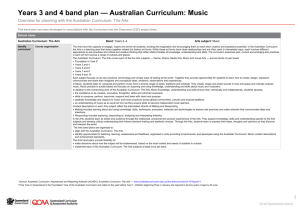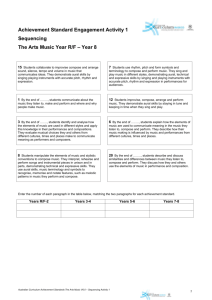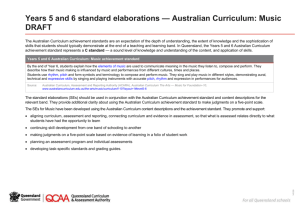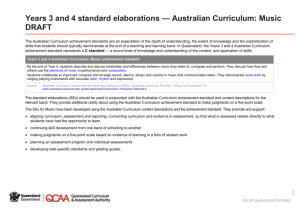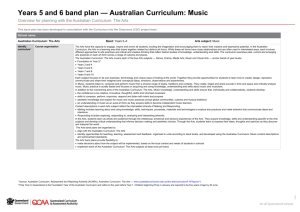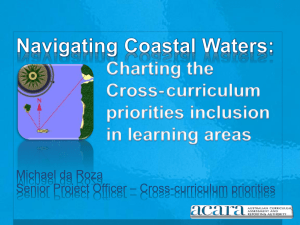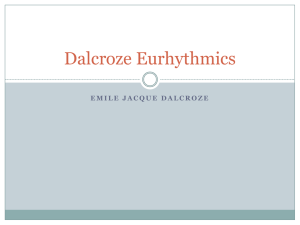music achievement
advertisement
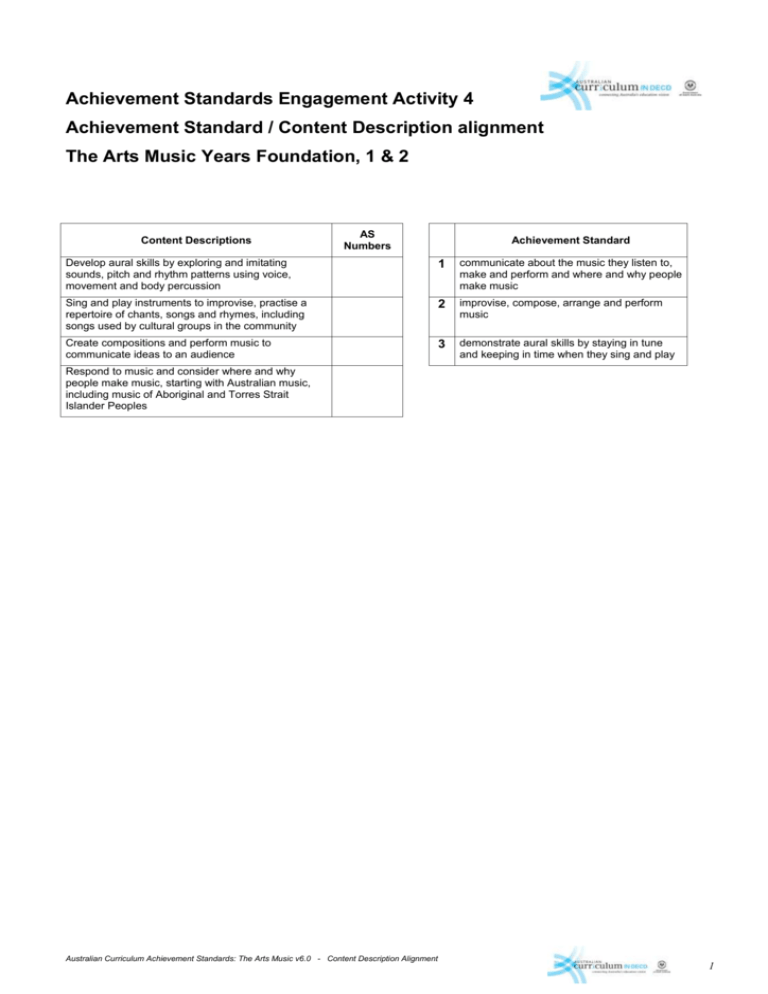
Achievement Standards Engagement Activity 4 Achievement Standard / Content Description alignment The Arts Music Years Foundation, 1 & 2 Content Descriptions AS Numbers Achievement Standard Develop aural skills by exploring and imitating sounds, pitch and rhythm patterns using voice, movement and body percussion 1 communicate about the music they listen to, make and perform and where and why people make music Sing and play instruments to improvise, practise a repertoire of chants, songs and rhymes, including songs used by cultural groups in the community 2 improvise, compose, arrange and perform music Create compositions and perform music to communicate ideas to an audience 3 demonstrate aural skills by staying in tune and keeping in time when they sing and play Respond to music and consider where and why people make music, starting with Australian music, including music of Aboriginal and Torres Strait Islander Peoples Australian Curriculum Achievement Standards: The Arts Music v6.0 - Content Description Alignment 1 Achievement Standards Engagement Activity 4 Achievement Standard / Content Description alignment The Arts Music Years 3 & 4 Content Descriptions AS Numbers Achievement Standard Develop aural skills by exploring, imitating and recognising elements of music including dynamics, pitch and rhythm patterns 1 describe and discuss similarities and differences between music they listen to, compose and perform Practise singing, playing instruments and improvising music, using elements of music including rhythm, pitch, dynamics and form in a range of pieces, including in music from the local community 2 discuss how they and others use the elements of music in performance and composition Create, perform and record compositions by selecting and organising sounds, silence, tempo and volume 3 collaborate to improvise compose and arrange sound, silence, tempo and volume in music that communicates ideas Identify intended purposes and meanings as they listen to music using the elements of music to make comparisons, starting with Australian music, including music of Aboriginal and Torres Strait Islander Peoples 4 demonstrate aural skills by singing playing instruments with accurate pitch, rhythm and expression Australian Curriculum Achievement Standards: The Arts Music v6.0 - Content Description Alignment 2 Achievement Standards Engagement Activity 4 Achievement Standard / Content Description alignment The Arts Music Years 5 & 6 Content Descriptions AS Numbers Achievement Standard Explore dynamics and expression, using aural skills to identify and perform rhythm and pitch patterns 1 explain how the elements of music are used to communicate meaning in the music they listen to, compose and perform Develop technical and expressive skills in singing and playing instruments with understanding of rhythm, pitch and form in a range of pieces, including in music from the community 2 describe how their music making is influenced by music and performances from different cultures, times and places Rehearse and perform music including music they have composed by improvising, sourcing and arranging ideas and making decisions to engage an audience 3 use rhythm, pitch and form symbols and terminology to compose and perform music Explain how the elements of music communicate meaning by comparing music from different social, cultural and historical contexts, including Aboriginal and Torres Strait Islander music 4 sing and play music in different styles, demonstrating aural, technical and expressive skills by singing and playing instruments with accurate pitch, rhythm and expression in performances for audiences Australian Curriculum Achievement Standards: The Arts Music v6.0 - Content Description Alignment 3 Achievement Standards Engagement Activity 4 Achievement Standard / Content Description alignment The Arts Music Years 7 & 8 Content Descriptions AS Numbers Achievement Standard Experiment with texture and timbre in sound sources using aural skills 1 identify and analyse how the elements of music are used in different styles and apply this knowledge in their performances and compositions Develop musical ideas, such as mood, by improvising, combining and manipulating the elements of music 2 evaluate musical choices they and others from different cultures, times and places make to communicate meaning as performers and composers Practise and rehearse a variety of music, including Australian music to develop technical and expressive skills 3 manipulate the elements of music and stylistic conventions to compose music Structure compositions by combining and manipulating the elements of music using notation 4 interpret, rehearse and perform songs and instrumental pieces in unison and in parts, demonstrating technical and expressive skills Perform and present a range of music, using techniques and expression appropriate to style 5 use aural skills, music terminology and symbols to recognise, memorise and notate features, such as melodic patterns in music they perform and compose Analyse composers’ use of the elements of music and stylistic features when listening to and interpreting music Identify and connect specific features and purposes of music from different eras to explore viewpoints and enrich their music making, starting with Australian music including music of Aboriginal and Torres Strait Islander Peoples Australian Curriculum Achievement Standards: The Arts Music v6.0 - Content Description Alignment 4 Achievement Standards Engagement Activity 4 Achievement Standard / Content Description alignment The Arts Music Years 9 & 10 Content Descriptions AS Numbers Achievement Standard Improvise and arrange music, using aural recognition of texture, dynamics and expression to manipulate the elements of music to explore personal style in composition and performance 1 analyse different scores and performances aurally and visually Manipulate combinations of the elements of music in a range of styles, using technology and notation 2 evaluate the use of elements of music and defining characteristics from different musical styles Practise and rehearse to refine a variety of performance repertoire with increasing technical and interpretative skill 3 use their understanding of music making in different cultures, times and places to inform and shape their interpretations, performances and compositions Plan and organise compositions with an understanding of style and convention, including drawing upon Australian music by Aboriginal and Torres Strait Islander artists 4 interpret, rehearse and perform solo and ensemble repertoire in a range of forms and styles Perform music applying techniques and expression to interpret the composer’s use of elements of music 5 interpret and perform music with technical control, expression and stylistic understanding Evaluate a range of music and compositions to inform and refine their own compositions and performances 6 use aural skills to recognise elements of music and memorise aspects of music such as pitch and rhythm sequences Analyse a range of music from contemporary and past times to explore differing viewpoints and enrich their music making, starting with Australian music, including music of Aboriginal and Torres Strait Islander Peoples, and consider music in international contexts 7 use knowledge of the elements of music, style and notation to compose, document and share their music Australian Curriculum Achievement Standards: The Arts Music v6.0 - Content Description Alignment 5
